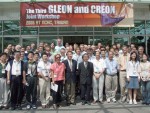Developing ties between the Moorea Coral Reef LTER and the Kenting Coral Reef ILTER in Taiwan
As part of the MCR-LTER project, now in its third year, we are developing international collaborations with other projects that also are focused on time-series analyses of tropical coral reef communities. Our goal is to use cross-site comparisons to test for generality in our conclusions, to shed light through the use of contrasting communities on the processes driving reef dynamics in Moorea, and to interact in mutually beneficial ways with colleagues having diverse and complementary skills to our own. As a means to this end, we have started working with the team of scientists associated with the Kenting Coral Reef ILTER project in southern Taiwan.
The Kenting Coral Reef (KCR) ILTER is located within the Kenting National Park, and many of its scientists work through the National Museum of Marine Biology and Aquarium (NMMBA) (http://eng.nmmba.gov.tw/). In October 2006, funds awarded by the NSF-OISE program were used to support a fact-finding mission to Taiwan by the four Principal Investigators and the Deputy Program Director of the MCR LTER project. Our goal was to meet the key scientists working on the KCR ILTER project, to evaluate the potential for collaborative research based on the research infrastructure and accessible coral reef habitats, and further, to continue with the early-stage planning for the application of streaming data technology to coral reefs through the Coral Reef Environmental Observation (CREON) initiative. The trip also included a joint MCR LTER and KCR ILTER Symposium "Recent Advances in Long-Term Research on Coral Reefs" held at the National Chung Hsing University (NCHU) in Taichung, Taiwan. In short, this first trip was extremely successful, and we were much impressed with the potential for exciting and highly rewarding collaborative research. In February 2007, we sent a second delegation to Taiwan, this time with the objective of completing small-scale research projects as a means to demonstrate the ability to work collaboratively to further our science objectives.
Our most recent trip provided nine days on-site in Taiwan, and the group consisted of Peter Edmunds, a co-PI on the MCR LTER project, and graduate students from UC Santa Barbara (Gerick Bergsma and Nichole Price) and CSU Northridge (Hollie Putnam), which are the lead institutions for the MCR LTER. Our visit was hosted by Dr. Tung-Yung Fan, an Associate Research Fellow at NMMBA, who is responsible for the coral reef time-series analysis for the KCR ILTER, and has extensive experience in the reproductive biology of corals. With Dr. Fan's advice, we scheduled our visit to correspond with the full moon when several coral species in culture at the NMMBA release large numbers of coral larvae. This was important to create opportunities for three members of the team to conduct ecophysiological research on the early life stages of corals. Peter Edmunds and his student, Hollie Putnam tested the effects of elevated temperature on the settlement and photophysiology of coral larvae, and Nichole Price explored the settlement preference of coral larvae for different types of coralline algae. The fourth member of our team, Gerick Bergsma, conducted field surveys on the shallow reefs to document of the abundance of amphipod-coral symbioses.
Our second trip to Taiwan brought sharply into focus the potential for collaborative research between the KCR ILTER and the MCR LTER, and of great importance, it also identified key areas for synergistic activity. Notably, it now is clear that contrasting research infrastructures in Moorea-which has unrivalled access to near-pristine ecosystems but modest capacity for laboratory analyses-and Taiwan-which has access only to a physically disturbed environment but has world-class laboratory and microcosm facilities - creates rich opportunities to advance scientific discovery in the area of coral reef community dynamics. Currently we are working with our colleagues in Taiwan to secure funding to realize our vision of future collaborative research, including visits by Taiwanese students and researchers to our universities in California and the MCR LTER site in Moorea.

 Enlarge this image
Enlarge this image
